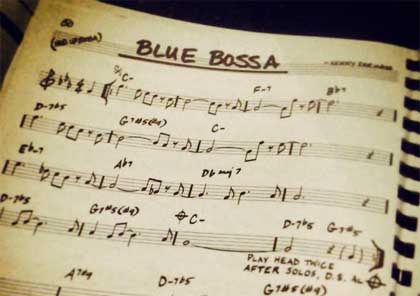« Dave Peters TAB: Au Privave! |
Main
| Online rebroadcast of Mike Marshall's ArtistWorks workshop »
 July 3, 2014 | Jazz Advice: The Real Book Player July 3, 2014 | Jazz Advice: The Real Book Player
An interesting article on the Jazz Advice blog was recently brought to our attention by one of our Australian readers, Professor David Lewis. Titled "Why You Shouldn't Be a Real Book Player," it takes a critical look at the dangers of becoming too dependent on "Real Book" use, the collection of jazz standards many players depend on at gigs and practice. The thrust is players get tied to a print umbilical cord, pun unintentional. We've witnessed this in pedagogy, the student jazzer that can't wean him/herself from the music stand, eyes perpetually glued to the security of staff and chord symbols.
Read article: Why You Shouldn't Be a Real Book Player

The author has merit to his argument, though we fear a baby-out-with-the-bathwater move.
Certainly, the Realbook should be considered notes to a performance, and not the script. If the page isn't considered a jumping off point, but a final interpretation, it becomes counter productive. However, we would argue players have three different approaches to internalizing music.
Kinetic: The scale exercises we do are great for absorbing melodic pathways. They aren't the journey, but they are a toolbox to fretboard prowess and accessibility. They are a means, not an end, and the skeleton of the leadsheet gives an immediate interpretation to a classic song that can be drilled over and over to free the intellect up to add flesh. Fingers first, brain, later.
Aural: Some learn better through hearing the tune. Nuance is captured and retained, and they are better equipped to live in the world of rote and sound. Not all of us have that ability, however.
Visual: A map internalized through the visual cortex is best for many. Some have to see words before they can hear them, and music can be the same way. SEE the chord. SEE the triad in the staff. SEE the accidental. This does have a disadvantage, absent the nuance of rhythm, tone color, and feel. Still, it can be a start, and in an ensemble situation, the players can begin and end a song with something mutual, organized, and uniform.
Though most will lean heavier in one of the three directions, it's best to incorporate all three in developing playing skills. A heavier kinetic base frees the brain to inject intellect and later, aesthetic. The visual offers community participation more effectively. Still, at the end it is music after all, and it must reign in the world of timbre and rhythm, or you end up with nothing but a stark audio crossword puzzle.
Strengths and Weaknesses of Realbook Playing:
Pro:
Instant access to form and melody.
Uniformity. Playing the head in an ensemble context uniformly.
Visual analysis of the harmonic framework of the song.
Breadth of repertoire, time to learn more songs.
Con:
Trapped in the sheet music--inescapable safety line.
Player's creativity limited, less likely to interact with rhythmic and harmonic shifts of the others.
Dependent on visual, you don't use ears to explore.
You are the drama of the script, not the character of the music.
Not learning by ear denies opportunity to develop your ear.
Purchase: Realbook
Further:
How we learn
Approaching Improvisation
The Joy of Mandolinning
Again. Fingers/Ears/Brain
Inner Game of Tennis
Posted by Ted at July 3, 2014 10:55 AM

Disclaimer: In the 'Information Age' of the 21st Century,
any fool with a computer, a modem, and an idea can
become a self-professed 'expert." This site does not
come equipped with 'discernment.'
|



